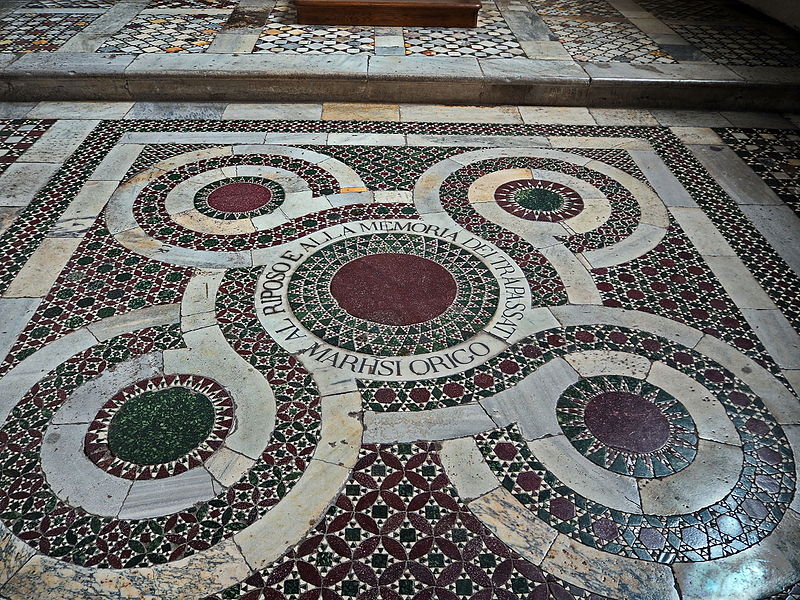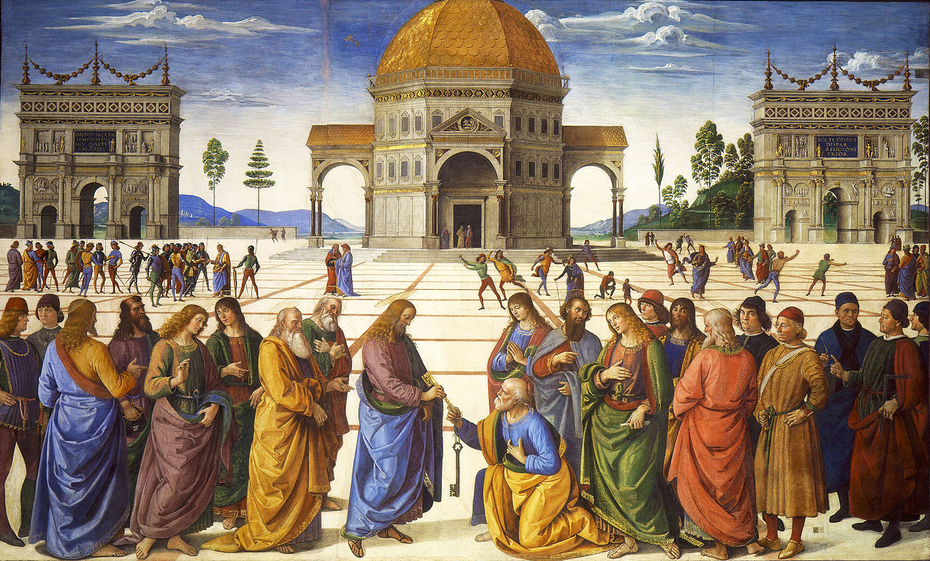Over recent months I seem to have concentrated on writing about artists who were practicing their trade during the Victorian period and the first couple of decades of the twentieth century. Yet, when I look back on my earliest blogs I seemed to have favoured the Dutch and Flemish painters of the sixteenth and seventeenth centuries. Today I am going to deviate again and look at the life and work of the fifteenth century Italian Renaissance painter Pinturicchio. I came across the artist and one of his major fresco commissions when I read the excellent blog io sto a casa, written by Jackie, an American teacher who lives with her Italian husband in Le Marche, Italy. She and her husband are lovers of art and often travel around the country visiting places of interest which hold artistic treasures. It was she who mentioned the artist Pinturicchio in one of her recent blogs.

Bernardino di Betto was born around 1454 in the Italian city of Perugia. He was also known by his nickname, Il Pinturicchio, meaning “little painter” because of his small stature. His parents were a family of artisans, his father being a cloth tanner. His early life seems to have been filled with unhappiness, compounded by the death of his father from the plague when Pinturicchio, was just a teenager. His first foray into the world of fine art came when the talented miniaturist, Giapeco Caporali opened a bottega (a workshop of a major artist in which other artists may participate in the execution of the projects or commissions of the major artist) close to Pinturicchio’s father’s house at Porta Sant’Angelo. Pinturicchio worked there for a time and would take a share of the profits of the work completed in the studio. In 1481 Pinturicchio joined the painters’ guild in Perugia. Perugia was at that time experiencing a great artistic fervour and the central Italian city was becoming a renowned hub for artistic activities of which Pinturicchio contributed. Once Pinturicchio had enrolled in the guild of Artists and Painters in Porta Sant’Angelo, Perugia, his output began to be recorded. He received many commissions and joint commissions for his fresco work.
Meanwhile, in Rome, the first phase of the work on the Sistine Chapel had been on-going. The fresco work had been carried out by some of the Italian Masters, such as Botticelli, Perugino, Ghirlandaio, Signorelli, Cosimo Rosselli and Pinturicchio. The first phase of this massive undertaking came to an end around 1482 and most of these Italian Masters returned to their home cities. This is with the exception of Pinturicchio who did not go home but instead remained in the city and set up a workshop. as he could take advantage of the opening left by the other great artists. He then chose a group of Italian painters who had collaborated with him at the papal chapel. His group contained artists from the many regions of the country who were willing to remain in Rome and work for him. Having set up this group and with many of the renowned artists having left the eternal city he was awarded his first commission in Rome by Nicolò Manno (Riccomanno) Angeli Bufalini, a consistorial lawyer and one-time bishop of Venafro, for his family chapel which was part of the Basilica of Santa Maria in Aracoeli in Rome, which stands on the Capitalone hill. Pinturicchio’s frescos in the Bufalini Chapel depicted scenes from the life of Saint Bernardino of Siena and Saint Francis. The commission was to remember the reconciliation that took place between the Bufalini family and the Baglioni of Perugia, thanks to St. Bernardino.

Pinturicchio and his team set to work on the chapel around 1484. On the vaulted ceiling there are depictions of the four Evangelists, Matthew, Mark, Luke and John, each seated on a cloud, in front of a dark blue, star-studded background.

The chapel itself has a quadrangular base, with the vault and floor decorated with cosmatesque mosaics. The Cosmatesque style takes its name from the family of the Cosmati, which flourished in Rome during the twelfth and thirteenth centuries and practiced the art of mosaic. The inside of the chapel comprises of three sides and the frescoes on the three walls are dedicated to the life and miracles of St. Bernardino of Siena, an Italian priest and Franciscan missionary, who was canonized as a saint in 1450, and who was very popular during the Renaissance. The frescos also featured two stories of St. Francis.

The back wall of the chapel, the altar wall, is decorated by a fresco entitled The Glory of Saint Bernardino. It is horizontally divided into two sections. The lower section depicts San Bernardino standing on a rock with outstretched arms. His right hand points up to Christ. In his left hand he holds an open book in which one can read:
PATER MANIFESTAVI NOMEN TVVM OMNIBVS
“Father, I have shown your name to everyone”,

Above him are two angels who are in the process of crowning him. Either side of him stand two saints,. On his right is St. Louis of Toulouse adorned in in his solemn episcopal robes and on his left stands Saint Anthony of Padua in a Franciscan habit.. In one of St Anthony’s hands he holds the flame symbolising his piety whilst in the other he holds a book symbolising his knowledge. The background of this lower section is a landscape with rocks, lakes and mountains, which extends the depth of the space. This scene is probably one Pinturicchio would have recalled from his homeland.

In the upper part of the fresco we see Christ in the act of blessing. His figure is encased in a mandorla. The term mandorla means an almond-shaped frame that surrounds the totality of an iconographic figure. Surrounding Christ are worshiping and music-making angels.
On entering the Bufalini Chapel, the wall to the left comprises of two scenes one atop the other, divided by a painted frieze. The upper part is a lunette, a half-moon shaped, or semi-circular, arch, which depicts St. Bernardino being penitent before the Porta Tufi in Siena and this fresco shows a young Bernardino’s first hermitage.

Upper lunette
The fresco on the lower part of the left-hand wall is much more interesting. It depicts the Funeral of Saint Bernardino.

The fresco on the lower part of the left-hand wall is much more interesting. It depicts the Funeral of Saint Bernardino. The setting is a city scene with a chessboard-like pavement. It is painted using geometrical perspective, which enables the depiction of a three-dimensional form as a two-dimensional image which carefully looks like the scene as visualized by the human eye. The vanishing point is a building similar to one depicted in Perugino’s painting, Delivery of the Keys, although Pinturicchio has two buildings of different heights at the sides. On the left is a loggia, a covered exterior gallery or corridor, supported by piers decorated with fanciful gilded candelabra. On the right is a cubic building connected through a double loggia to the landscape and the bright sky in the background.

The foreground is dominated by the Saint Bernardino’s funeral. We see his body laid out on what is termed a catafalque, a decorated wooden framework supporting the coffin of a distinguished person during a funeral or while lying in state. Its presence increases the sense of spatial depth

All sorts of folk, friars, pilgrims and the “common” people approach the body to pay their respect. Look at the tall figure in the left foreground wearing the brown robe, with a fur-lined hood and gloves. He is Riccomanno Bufalini, the person who commissioned the frescoes.
The remaining characters we see standing around the coffin often portray a series of miracles attributed to Bernardino during his life. We see the once-blind man who was healed and given back his sight by the body of Bernardino, standing by the head of the coffin pointing to his eyes. There is the resurrection of someone possessed by the Devil, the healing of the stillborn baby of John and Margaret Basel, the healing of Lorenzo di Niccolo da Prato, wounded by a bull, and the pacification of the warring Umbrian Bufalini and Baglioni families.


The right wall of the Bufalini Chapel features a double mullioned window. Pinturicchio has implemented an illusionistic perspective, when he painted two imitation symmetrical windows, one depicting a blessing from God the Father and the other featured a peacock which was an early Christian symbol of immortality.

There is also a fresco featuring, on the left, a scene from the life of St. Bernardino of Siena in which we see him receiving the religious habit. It is set in an oblique perspective that exploits the decorated pillars with a grotesques arch. Finally, there is a small scene on the right featuring, in the background, a view of the Verna Sanctuary over a rocky peak which depicts St. Francis in the act of receiving the stigmata, in honour of the Franciscan foundation of the Aracoeli.
Under the real window is an illusory opening depicting five characters: among them is an aged friar, perhaps the convents prior, and a lay figure that resembles him, perhaps an administrator of the basilica.
In the next blog I will be looking at the frescoes by Pinturicchio on the walls of the Baglioni Chapel in Spello.
………………………………to be continued.





